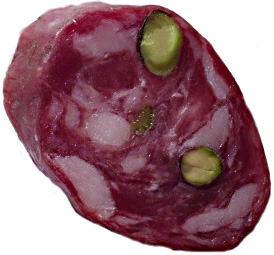...Best of Sicily presents... Best of Sicily Magazine. ... Dedicated to Sicilian art, culture, history, people, places and all things Sicilian. |
by Roberta Gangi | ||
Magazine Index Best of Sicily Arts & Culture Fashion Food & Wine History & Society About Us Travel Faqs Contact Map of Sicily |
Similar to salami is bresaola, a salted, air-dried horse meat or beef similar to beef jerky, though the latter is usually marinated and then smoked before drying, resulting is a slightly chewy product. Salami (whose name, like salumi, derives from the Italian sale meaning "salt") is made by filling beef or pork intestines with chopped, spiced meat. Such things as venison salami exist, and in Italy it is not unusual to add walnuts or pistachios to the mixture, as shown here. Either before or after filling the casing, there is a brief fermentation, a process requiring no small degree of skill to ensure that the salami doesn't spoil. Most salami is air-dried. This completes the curing. Traditionally, it would take a few months to produce a good salami. The longer the time allowed for curing, the sharper (less sweet) the taste. Most salami is not, strictly speaking, cooked but - like ham - it can be. We do not know precisely when salame was introduced in Sicily. Historical lore says that Sicilian knights travelling through Piedmont's Po Valley (around Monferrat) toward Germany with Frederick II who were supplied with salami made the food known in those regions. However, there is evidence to suggest that salami was made in northern Italy and north of the Alps before the thirteenth century. Whatever its origin, pork salami is delicious. About the Author: Roberta Gangi has written numerous articles and one book dealing with Italian cultural and culinary history, and a number of food and wine articles for Best of Sicily Magazine. | |
Top of Page |
 The Sicilian Black
The Sicilian Black